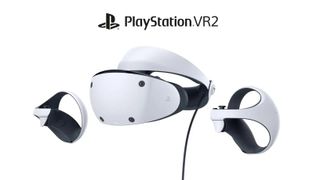The PSVR 2 headset has been designed with sweaty gamers in mind
Say hello to the new PSVR 2 headset

After over a year of waiting, Sony has finally shown off the PSVR 2 headset design – and it isn’t a dramatic departure from what we’ve seen before. However, there is one unexpected addition to the company's upcoming headset: a ventilation port.
The new PSVR 2 headset, which builds upon the PSVR’s original look and is slimmer and slightly lighter than the previous device, also includes integrated ventilation to stop you from getting overly sweaty during those intense Beat Saber sessions.
If you're the type who works up a sweat rather easily when immersed in the world of VR, this vent could stop the PSVR 2's lenses from fogging up, and will hopefully make wearing the device more bearable in the summer months.
In a post on the PlayStation Blog, Sony Interactive Entertainment's senior art director Yujin Marisawa explained why the ventilation port was such a key addition that the team wanted to implement.
“When I started to work on the design for the PlayStation VR2 headset, one of the areas I wanted to focus on first was the idea of creating a vent in the headset to let air out, similar to the vents on the PS5 console that allows airflow," said Marisawa-san. "Our engineers came up with this idea as a good way to allow ventilation and avoid having the lens fog up while players are immersed in their VR games.
"I worked on many design concepts to achieve this, and in the final design, you can see there is a little space in between the top and front surface of the scope that contains the integrated ventilation. I am really proud of how this turned out and the positive feedback I have gotten so far. I hope our PlayStation fans will also agree, and I can’t wait for them to try it out.”
Sony also said that the PSVR 2's headset design is similar to that of its first VR headset as the company had a lot of "positive feedback on the ergonomics of the first PSVR headset". On the PSVR, the headband is once again adjustable and you can now adjust the scope area so it sits closer or further away from your face. There's also a lens adjustment dial that allows you to match the lens distance between your eyes to optimize your view.
The headset's white and black aesthetic matches that of the PS5, with rounded edges similar to that of the DualSense controller and the Pulse 3D Headset, so it should blend in nicely with your existing setup, provided you haven't changed the PS5 covers or picked up one of the many new colorful controllers.
Analysis: will we see the PSVR 2 this year?


We now have one of the last pieces of Sony's PSVR 2 puzzle: a look at the headset's design. Sony began by showing off the PSVR 2 Sense controllers, which appear to be a dramatic improvement over the PlayStation Move wands, and later shared the device's impressive specs at CES 2022.
Sony is aiming to release the PSVR 2 by the end of 2022, depending on if it can overcome ongoing supply issues created by the global semiconductor crisis. With PS5 consoles still hard to find, the idea of Sony selling a peripheral for hardware that millions are unable to buy may seem a little crass, but the Japanese company clearly believes in virtual reality and wants to get its headset to market sooner rather than later.
That makes sense considering how much VR is in the public eye right now with the metaverse, in particular, a growing trend in the space. VR headsets like the Oculus Quest 2, which is now called the Meta Quest 2 after Facebook's rebrand, have become more popular in recent years too, so Sony will be hoping it can make its second foray into VR a more substantial one.
Get daily insight, inspiration and deals in your inbox
Get the hottest deals available in your inbox plus news, reviews, opinion, analysis and more from the TechRadar team.
The first game for PSVR 2 has already been announced - a spin-off to Horizon Forbidden West called Horizon Call of the Mountain - but we still don't know how much Sony's new headset will cost. Hopefully, we'll get that final piece of information soon, along with a firm release date.
- PS5 vs PS5 Digital Edition: what's the difference?
Adam was formerly TRG's Hardware Editor. A law graduate with an exceptional track record in content creation and online engagement, Adam has penned scintillating copy for various technology sites and also established his very own award-nominated video games website. He’s previously worked at Nintendo of Europe as a Content Marketing Editor and once played Halo 5: Guardians for over 51 hours for charity. He is now an editor at The Shortcut.
Most Popular


